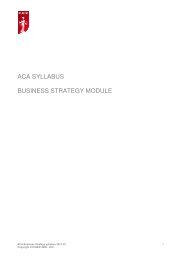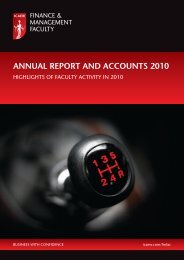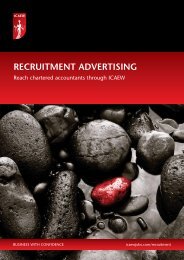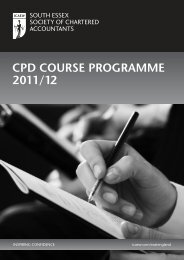Best practice guideline-SME Finance - ICAEW
Best practice guideline-SME Finance - ICAEW
Best practice guideline-SME Finance - ICAEW
Create successful ePaper yourself
Turn your PDF publications into a flip-book with our unique Google optimized e-Paper software.
<strong>guideline</strong>INVESTMENT READINESSMany small businesses would benefit from furthersupport to turn their business propositions intoattractive investible opportunities. Securing fundingis often closely related to how well businesses makethemselves ‘investment-ready’ for potential investors.THE BUSINESS PLANPreparing a solid business plan is key to securingfunding. A robust plan will help potential lendersor investors understand the vision and goals of thebusiness. The process of preparing a business plan willbring focus to management’s understanding of theirstrategy – where the risks are and the impact of anydeviation from the plan – in particular when it comes tofunding.The information will depend on the target audience,but in each case it should incorporate:• an executive summary, highlighting the main pointsand designed to grab the attention of potentiallenders or investors;• details of key people as well as their responsibilities,skills and relevant business experience;• market research, with details of competitors andhow the product or service fits into the marketplace;• the marketing plan to increase sales of the productor service to new or existing customers;• financial information covering the last three yearsof trading (if available) – accounts (audited, ifavailable) and key accounting ratios;• financial forecasts for the next three to fiveyears, ideally presented in the same way as thehistorical information, highlighting key underlyingassumptions;• additional forecasts, which clearly show the financialimpact of key downside scenarios, such as salesgrowth targets not being met, also need to beincluded;• a cash flow forecast covering the next two to threeyears (or in the case of a start-up or turnaround,until the business moves into profit), indicating theamount of funding needed;• how creditors, capital expenditure, debtors andstock will be managed over the forecast period; and• how any potential lenders will get their money back,or investors will see the value of the business andtherefore their shareholding grow.Any business plan must clearly show how much of theexisting owner’s money is committed to the business.If a lender or investor thinks the existing owner is notdemonstrating a willingness to risk enough of their owncapital, securing a loan or an investment is likely tobe more difficult, if not impossible. The business planshould also clearly detail any backing already receivedfrom other banks or investors which may demonstratethe investibility of the business and attract new lendersor investors.In general terms, if a business is looking for debtfinance, the plan needs to demonstrate how thebusiness will be able to meet the interest payments andrepay the capital over the period of the loan.When looking for equity finance, the plan will need toshow how the equity provider will receive dividendsand how share value will grow.BUSINESS MENTORINGInvestment readiness may be the initial goal of an <strong>SME</strong>looking for funding, but before a business plan can beprepared the business may need to access experiencedadvisers’ knowledge and information in order to makethe right choices.Business mentors have the practical experience andcontacts to help businesses make those right choices.A mentor acts as an independent sounding board,can provide guidance and support from an externalperspective and signpost a business to appropriateexternal advice.Box 1: Mentorsme.co.ukMentorsme.co.uk is a mentoring gateway that linksbusinesses to mentoring organisations across the UKand can help find a mentor that suits the business,including those offering specialist financial support.The British Bankers’ Association (BBA), the hostsof the portal, has provided 1000 volunteer bankmentors recruited from the business communitywho can offer expert financial support and all areaccessible via mentorsme.co.uk.icaew.com/cff 03
<strong>guideline</strong>Business coachingCoaching will help the business produce a robustfinancial strategy and business plan. Presentationtraining will give management the skill to present thecompany and their plans in the best possible light,and deal with the rigorous scrutiny of those plans bypotential lenders or investors. At this stage the advisershould be able to introduce the company to a networkof investors or lenders. Many independent advisoryfirms offer coaching and mentoring services.Box 2: <strong>ICAEW</strong> Business Advice Service<strong>ICAEW</strong>’s Business Advice Service (BAS) is a schemeoffering business support to <strong>SME</strong>s in England,Scotland and Wales.The scheme offers businesses a free advice sessionwith an <strong>ICAEW</strong>-qualified chartered accountant.Businesses can visit www.businessadviceservice.comto find the nearest office participating in the scheme.BAS offers to help <strong>SME</strong>s overcome the challenges of:• how to grow a business;• securing loans, capital and finance;• keeping staff and creating new jobs;• meeting tax and regulatory requirements;• export planning;• planning for long-term sustainable growth;• debt management; and• legal issues.Box 3: GrowthAcceleratorGrowthAccelerator is a £200m government-backedprogramme to provide business coaching to English<strong>SME</strong>s. A private sector consortium of business growthspecialists, led by Grant Thornton and comprisingWinning Pitch, Oxford Innovation and Pera, deliversthe scheme.Coaching is not prescriptive – it is tailored tomeet the specific needs of individual businesses.Proven business experts work with the business’smanagement team to identify the barriers to growth,devise and agree a strategy to overcome thosebarriers and then work with them to execute theplan.GrowthAccelerator focuses on four main areas:• Commercialising innovation – teaching businessleaders how to commercialise their ideas, developinnovation strategy and generate profitableintellectual property.• Business development – helping business ownersto develop and execute a clear growth strategy inline with their specific needs.• Access to finance – this provides an assessmentof business suitability and potential for raisingfinance; it helps create a business that isinvestible, and introduces a business to potentiallysuitable investors.• Leadership and management –GrowthAccelerator provides grants for trainingcourses that will enable senior managers and chiefexecutives to create an effective managementstructure and run their business better.In addition to business coaching, GrowthAcceleratorfast tracks clients to trusted providers of businessadvice. It introduces businesses to networks ofinvestors. It also connects them to similar businesses.English <strong>SME</strong>s with no more than 250 employeesand turnover of up to £40m can apply for theGrowthAccelerator programme. It aims to help10,000 <strong>SME</strong>s per annum once fully up and running.04 <strong>SME</strong> <strong>Finance</strong>
THE RIGHT TYPE OF FINANCEAfter the preparation of a robust detailed business planwith realistic financial forecasts the next step for <strong>SME</strong>sis choosing the right type of finance. This may be a mixof two or more types of finance. The first port of callcould be further finance from the existing owners of thebusiness. This is not always possible.What must be determined before approaching lendersor investors is how much funding the business is likelyto require, what the funding is specifically needed forand when it will be required.For start-up businesses, running expenses must befactored in, in addition to the initial start-up costs.Sufficient capital should be available to cover theprojected running expenses for at least six months ascustomers may not pay up immediately. A start-upbusiness is unlikely to generate surplus funds in theseearly stages. It is critical that the owners establish howmuch money the business will need to survive.A start-up business may look to use credit unions oreven the owner’s credit card to fund that early stagegrowth. However, as with all means of financing,owners must look closely at the cost, particularly ifusing their own credit card to fund the start-up.Taking a business on to the next stage – moving to largerpremises, acquiring a competitor or investing in newmachinery to handle bigger orders – will almost alwaysrequire a further tranche of funding. Most businesses willuse a mixture of financing sources. Choosing the mostsuitable depends on the nature of the business, howmuch is actually needed and what exactly it is for.The overarching decision is between equity (shares)and debt. It may be that if the business is at an earlystage – pre-revenue or pre-profit – the only option isequity. Knowledge-based businesses which are richin intangible assets can find it difficult to access debtfinance. Equity finance may be particularly suitablefor these businesses. See Other Help for <strong>SME</strong>s forinformation on other sources of funding for knowledgebasedbusinesses.In <strong>practice</strong> a business generating turnover and makinga profit will use a mix of permanent and temporaryfinance. Grants may also be available in certainsituations. Another option may be to make use of somealternative forms of debt financing, such as invoicediscounting or export factoring.Box 4: Friends and familyIt might be possible for a business to raise some orall of the funding required from relatives or friends.A loan is probably the most appropriate option forimmediate or short-term funds. For longer-term orpermanent funding friends or family could be giventhe opportunity to invest in shares in the business.The advantages of ‘friends and family’ financing caninclude:• low or zero interest repayments;• loan obtained without the business giving anysecurity;• a longer loan period before the lender expectsrepayment of part or all of the loan, or the investora return on their investment;• greater flexibility; and• requirement for a less detailed business plan if thelender or investor already knows the circumstancesof the business.Despite the seemingly informal nature of the investmentor loan from the friend or family member, they must bemade aware of the risks involved in investing or lending.They should not invest or lend more money than theycan afford to lose. If conventional lenders are unwillingto offer finance to the business, then the friend or familymember must seriously consider the reasons for thatand whether it is a viable proposition.One potential issue is when an inexperienced investortries to get involved in the running of the business.Their involvement may not be welcome and may bedetrimental to the business achieving its plans. It isimperative that where a passive partner is required,that is made clear from the outset. To maintaincontrol of the business a majority of the shares shouldbe retained by the original business owners. Otherproblems can arise if the investor or lender demandstheir money back prematurely.To avoid such problems, both parties should seekindependent advice and formalise any agreementin writing. The agreement should detail the natureand timing of the return of any loan, a repaymentschedule or timed plan of dividend payments, and therespective responsibilities of both parties. There shouldalso be an agreed procedure for the resolution of anyproblems which may arise, to help prevent any futuremisunderstandings. It is important to be aware thatthe exact nature of any agreements could have taximplications for either or both parties.icaew.com/cff 05
<strong>guideline</strong>INDEPENDENT ADVICEIt is important to obtain independent advice whenconsidering financing options. The type of financesought should match the needs of the business.Advisers can help the business establish whether theyneed to raise finance or whether their problems canbe addressed in other ways such as better financialmanagement and control.DEBT FINANCEBANK FINANCE – LOANS AND OVERDRAFTSOverdrafts and bank loans are the most commonsources of additional finance for <strong>SME</strong>s. The mostsignificant advantage they have over raising equityis that neither involves relinquishing any share ofownership or control of the business.It is almost always the case that an entrepreneur willbenefit from the knowledge, insight and network ofadvisers who deal with banks on a day-to-day basis.However, businesses themselves should cultivaterelationships with banks because that relationship mayprove fruitful, particularly when looking for followupfunding. Broadly, loans are often better for largerlong-term purchases, such as investment in plant andmachinery. Authorised overdrafts are more suitable forday-to-day borrowing.SECURING A BUSINESS LOAN OROVERDRAFTTo successfully obtain a loan or overdraft, the businessowner will have to prove to the lender that the businesswill generate the income necessary to repay the facilityin accordance with the terms of the loan. Marketconditions affect greatly the ease with which a businesscan access a loan or overdraft.A business will generally need to:• show a comprehensive and credible business plan,including cash-flow projections demonstrating thatthere will be sufficient income to cover outgoingsand meet interest and capital repayments;• provide evidence of a successful track record inbusiness or of skills and experience relevant to thebusiness being started;• provide security for any money borrowed – againstother personal or business assets; and• demonstrate the owners’ personal financialcommitment to the business.Box 5: Bank loans – pros and consThe main advantages of loans are:• the terms can be tailored to suit the needs of thebusiness;• repayments are straightforward, simply plannedand the cash flow impact can be budgeted for;• a loan usually costs less in interest payments thanan overdraft when used over the same term; and• there is tax relief on the interest payments, unlikedividends.The disadvantages are:• banks can be reluctant to lend money to newbusiness owners with no financial track record;• loans are less flexible than overdrafts – chargescould be payable on funds that are not used andthere could be penalties for early repayment;• being locked into a rigid repayment schedule couldbe a problem if cash flow is seasonal or erratic; and• in almost all instances there will be a need for abusiness to put up security against the loan, and/orthe directors to give personal guarantees.CHOOSING A BANK ACCOUNTBank charges vary widely – as do the services offered – soit is worth shopping around before opening any account.The suitability of an account will depend on the needs ofthe business. For example, where a business has manytransactions, they should consider opting for an accountwhich charges a fixed fee rather than an amount pertransaction.Statements should be checked regularly not just fortransactions but for bank charges, which can be kept toa minimum by:• negotiating or switching banks to secure betterinterest rates and lower charges;• automating as many transactions as possible,using standing orders, direct debits and electronicpayments;• using on-line banking where available; and• adhering to the terms and conditions of theaccount, for instance avoiding unauthorisedoverdrafts.06 <strong>SME</strong> <strong>Finance</strong>
It is important to notify the bank if the business ishaving financial difficulties. Negotiating new conditionsfor an account is always better than breaching a termsuch as exceeding a credit limit. This will incur extrafees and could affect the owner’s credit rating.Box 6: Overdrafts – pros and consThe main advantages of overdrafts are:• they are often quicker to arrange than a loan;• overdrafts give flexibility – interest is only paid onthe amount of money used and they are only usedas finance if required; and• they are regularly reviewed.The main disadvantages are:• they are repayable on demand and so can be calledin if the bank thinks that the business may be indifficulty;• interest rates are usually higher than for loans –using them for long-term borrowing will cost more;• cheques bouncing may lead to penalty chargesand/or higher interest rates if the overdraft limit isexceeded;• penalties may be imposed if the overdraft limit isexceeded; and• security may still need to be provided.DEBT FUNDING INNOVATIONSOne major innovation in the supply of debt to <strong>SME</strong>sis peer-to-peer (P2P) funding. It is still at a very earlystage but the UK appears to be at the forefront of thisinnovation which uses the power of the internet tomatch would-be lenders to would-be borrowers.There are a number of websites offering this service,which can be attractive both to businesses lookingfor quick access to lending and lenders looking forpotential returns. All parties should carefully considerthe risks of what is currently a largely unregulatedmarket.Box 7: Getting the best loan dealShopping around for the best loan deal is a must.Carefully comparing interest rates before decidingon the best deal can save the business a lot of moneybecause they can vary enormously.• Interest rates can be fixed or variable. With a fixedrate the interest will remain constant throughoutthe repayment period. With a variable rate, it mayfluctuate according to changes in the Bank ofEngland base rate or the interbank lending rate,LIBOR.• The annual percentage rate (APR) is the key figureto look at when comparing different loans andoverdrafts. This is the rate which will be chargedannually once all fees have been taken intoaccount. It may be possible to negotiate a lowerinterest rate or better terms – if so it is importantto get this confirmed in writing.• A finance broker or an accountant may be ableto track down a suitable loan and deal with theapplication process. Similarly, having an expertsuch as a solicitor to review the loan agreementwould be useful. The small print can be checkedfor any hidden costs. As well as interest ratesparticular attention should be paid to any set-upfees and loan terms, such as penalty charges forearly loan repayment.• The credentials of potential lenders can bechecked with the Financial Services Authority(FSA) or, from 2013, its successor organisations.Box 8: Community Development <strong>Finance</strong>InstitutionsCommunity Development <strong>Finance</strong> Institutions(CDFIs) are independent financial institutionswhich provide micro-finance loans to start-upcompanies, individuals and established enterprises.These loans are offered to borrowers from a specificdisadvantaged geographic area or disadvantagedgroup, who are unable to access finance from moretraditional sources, such as banks.Some CDFIs are also EFG accredited (see Box 9).icaew.com/cff 07
<strong>guideline</strong>Box 9: Enterprise <strong>Finance</strong> GuaranteeThe Enterprise <strong>Finance</strong> Guarantee (EFG) scheme isa loan guarantee scheme which aims to facilitateadditional lending to viable <strong>SME</strong>s. These businesseswill lack the security or proven track record for acommercial loan. Lenders are also likely to requestpersonal guarantees.EFG is available to <strong>SME</strong>s with annual turnover of upto £41m, seeking loans between £1,000 and £1m,and repayable over a period of 3 months up to 10years.Accredited lenders make all the lending decisionsrelated to EFG – there are currently 46 accreditedlenders, including all the main UK high street banks,Community Development <strong>Finance</strong> Institutions (seeBox 8) and invoice finance providers.EQUITY FINANCEEquity finance enables the raising of share capital fromexternal investors in return for handing over a share ofthe business. The main providers of equity finance for<strong>SME</strong>s are venture capitalists (VCs), business angels andfor start-ups, friends and family.Unlike lenders, equity investors do not have rightsto interest or to have their capital repaid by a certaindate. Their return is usually paid in dividend paymentsand is dependent on the growth in profitability of thebusiness. Because of the risk to their returns equityinvestors expect a higher potential return than on moresecure investments.Equity finance may be particularly suitable where thenature of a business deters conventional lenders suchas banks (for example, where a business is rich inintellectual property but has few tangible assets), orthe business will not generate enough cash to pay loaninterest because it is needed to fund core activities orgrowth.BUSINESS ANGELSBusiness angels are individuals who make equityinvestments in high-growth businesses. Some invest ontheir own; some invest as part of a syndicate.Investments by business angels tend to be smaller thanthose offered by VCs and tend to target businessesin the early stage of development or establishedbusinesses looking to expand. Angels will invest in highriskopportunities if there is potential for high returns.Typically between £10,000 and £2m can be raised fromangels, either alone or in a syndicate.When angels invest in a business it is not just theircapital they put in – most also make their valuablefirst-hand experience available to the business, as wellas their skills and network of contacts. They are likelyto have local knowledge as they usually focus theirinvestments within a small geographical area. Angelscan often make an investment decision relativelyquickly, without complex assessments.VENTURE CAPITAL AND PRIVATE EQUITYWhen VCs invest in shares in a business they are usuallylooking for products or services with a unique sellingpoint, or competitive advantage, with the potential forhigh returns. VCs will typically look for proven trackrecords and so will only rarely invest in pure start-upbusinesses. VCs bring their wealth of experience to thebusiness. They are very unlikely to get involved in theday-to-day running of the business but will often helpwith business strategy. Securing a deal with a VC can bea long and complex process. A detailed business planwill need to be prepared. The legal fees incurred in thedeal negotiation will be a cost regardless of whetherinvestment is ultimately secured.Private equity (PE) firms look to make equityinvestments in established companies with high-growthpotential. Generally, PE firms invest in businesseswhich are further developed than those VCs invest in.The investment is intended as medium to long term.They typically look to make operational improvementsthrough active management of their investment over aperiod of three to seven years. At the end of this periodthey look to sell their shares and exit the investmentcompletely, having seen the value of their stake grow. Aprivate equity firm will consider selling the business toanother private equity firm or a trade buyer as well asthe option of publicly listing their shares.08 <strong>SME</strong> <strong>Finance</strong>
SECURING EQUITY FINANCEBefore seeking equity finance there are five questions toconsider:• How much funding is required?• For what is it required?• What skills does the business need?• What level of control needs to be retained?• How long are the funds needed?The answers to these questions can form the basisof a comprehensive business plan. This should alsoincorporate realistic financial projections, a detailedmarketing plan and what the investor can expect inreturn.Networking and making use of suitable contacts aregood ways of finding appropriate potential investors.Corporate finance advisers will have their networksof contacts in the business angel and venture capitalcommunities and so engaging an adviser can helpidentify an appropriate investor.Many are private investors, only interested in specificindustry sectors or geographical areas. The followingassociations may be helpful for tracking down investors,networks or networking opportunities:• The UK Business Angels Association.• The British Private Equity and Venture CapitalAssociation (BVCA).• The European Private Equity and Venture CapitalAssociation (EVCA).• Chambers of commerce.Box 10: Equity finance – pros and consThe main advantages of equity finance are:• the funding is committed to the business and itsintended projects with investors only realisingtheir investment if the business has performedwell through a flotation or a sale to otherinvestors;• the right angels or VCs can bring valuableresource to the business, by way of skills,experience and contacts, which they canuse to assist in key decision making and thedevelopment of the business strategy;• investors have a direct vested interest in thesuccess of the business and its strategy, as itsgrowth and profitability will increase the value ofthe business and therefore their shareholding; and• investors are often prepared to provide follow-upfunding as the business grows.The main disadvantages are:• raising equity finance is demanding, costly andtime consuming, and the business may suffer astime is devoted to the deal;• potential investors will seek backgroundinformation, scrutinising past results and forecasts,as well as the background of the managementteam;• the business will be subject to varying degrees ofinfluence over its management when faced withmajor strategic decisions;• management time will need to be invested inproducing regular information for the investor tomonitor;• the owner’s share in the business will be diluted,although because of the funding this may be asmaller percentage of a larger business; and• there can be legal and regulatory requirements tocomply with when raising equity finance.icaew.com/cff 09
<strong>guideline</strong>Equity funding innovationsJust as with debt innovations, there are innovations inpeer-to-peer equity funding. Crowdfunding createsa platform which matches companies with would-beangel investors, sometimes novice angels.Deal sizes and investment sizes are small. Limited duediligence is carried out by the platform with it left up tothe investor as to how much due diligence is needed tosatisfy their needs.In August 2012 the FSA issued a warning that, in itsview, some crowdfunding firms may be handling clientmoney without FSA permission or authorisation andtherefore may not have adequate protection in placefor investors.Box 11: Business Angel Co-Investment FundThe £50m Business Angel Co-Investment Fund makesinitial equity investments of between £100,000 and£1m in early stage <strong>SME</strong>s identified as having highgrowth potential. Its investments are made alongsidesyndicates of business angels, subject to geographicalrestrictions. There is an upper limit to the stake it takesin a business of 49% of any investment round.The aim of the fund is to boost the quality and quantityof business angel investing in England, and supportlong-term, good quality jobs in high-growth companiesparticularly in areas worst affected by public spendingcuts.A consortium of private and public bodies withexpertise in business angel investment designed andestablished the fund, which is funded with a grant fromthe Regional Growth Fund.Investment decisions are made by the fund’sindependent investment committee, based upondetailed proposals put forward by business angelsyndicates.Box 12: Enterprise Investment SchemeThe Enterprise Investment Scheme (EIS) is designedto help smaller higher risk trading companies raisefinance by offering a range of tax reliefs to investorswho subscribe for new shares in those companies.• Investors can invest up to £1m in qualifyingshares and receive 30% of the cost of theinvestment as a relief against income tax.• Capital gains tax liability on disposal of an existingasset can be deferred if reinvested in EIS shareswithin a certain period.• Provided income tax relief is given and the sharesare held for a qualifying period, any profit onthe sale of the shares will be exempt from capitalgains tax.• Providing that income tax relief has been givenand has not been withdrawn, losses arising on adisposal of the shares may be set against incometax as an alternative to being relieved againstcapital gains tax.Companies can raise a maximum of £5m in any12-month period from the government’s threeventure capital schemes – the EIS, SEIS (see Box 13)and VCTs (see Box 14).The EIS is administered by HM Revenue & Customs(HMRC).At the time of the new shares being issued companieseligible to receive investment through the EIS must:• not be listed on the London Stock Exchange orany other recognised stock exchange;• have fewer than 250 full-time equivalentemployees;• have assets of no more than £15m; and• be carrying on or preparing to carry on a‘qualifying trade’ as defined by HMRC.There are further requirements which the companymust meet for a continuous period from the issue ofthe shares.10 <strong>SME</strong> <strong>Finance</strong>
Box 13: Seed Enterprise Investment SchemeThe Seed Enterprise Investment Scheme (SEIS) isdesigned to help smaller, early-stage companies to raiseequity finance. It complements the EIS (see Box 12).At the time of the new shares being issued companieseligible to receive investment through the SEIS must:• not be listed on the London Stock Exchange orany other recognised stock exchange;• have fewer than 25 full-time equivalentemployees;• have assets of no more than £200,000;• must not have had any EIS investment orinvestment from a VCT (see Box 14); and• must be carrying on a new qualifying trade orpreparing to do so. A new qualifying trade is onewhich has not been carried on for more than twoyears (whether by the company or by anyone elsebefore the company acquired it).Companies can receive a maximum of £150,000under the SEIS. Companies can raise a maximum of£5m in any 12-month period from the government’sthree venture capital schemes – the EIS (see Box 12),SEIS and VCTs (see Box 14).The SEIS offers a range of tax reliefs to encourageindividual investors to purchase new shares inqualifying companies. Shares must be held for at leastthree years and income tax relief is available at 50%of the cost of the shares, up to a maximum annualinvestment of £100,000. For 2012–13 only, thereis an exemption from capital gains tax where gainson the disposal of an asset are reinvested in sharesqualifying for SEIS income tax relief. Any gain ondisposal of SEIS shares will be exempt from capitalgains tax.Box 14: Venture Capital Trust SchemeThe Venture Capital Trust (VCT) scheme encouragesindividuals to invest in small, unlisted higher-risktrading companies indirectly through the acquisitionof shares in a VCT. VCTs are similar to investmenttrusts and must have HMRC approval.The maximum investment in VCT shares by anyindividual in any year is £200,000, which will qualifyfor relief against income tax at a rate of 30% of theamount invested. Shares must be held for at least fiveyears from the date of their issue by the VCT. Thereis an exemption for capital gains tax on disposal ofshares in a VCT, and dividends on VCT shares areexempt from income tax.VCTs invest their funds into eligible small companies.Eligible companies can receive both debt and equityinvestment from a VCT. At the time the VCT investsan eligible company must:• not be listed on the London Stock Exchange orany other recognised stock exchange;• have assets of no more than £15m;• have fewer than 250 full-time equivalentemployees; and• be preparing to carry on, or carrying on, a‘qualifying trade’ as defined by HMRC.There are further requirements which the companymust meet for a continuous period from the issue ofthe shares.Companies can raise a maximum of £5m in any12-month period from the government’s threeventure capital schemes – the EIS (see Box 12), SEIS(see Box 13) and VCTs.icaew.com/cff 11
<strong>guideline</strong>ALTERNATIVE SOURCES OFFINANCECOMMERCIAL MORTGAGESThe advantages of buying a property for a businessusing a commercial mortgage includes protectionagainst sudden rent increases. Such interest paymentsare also tax deductible.However most providers of commercial mortgageswould expect the buyer to invest a proportion of theirown money in the property. This deposit could swallowup cash that could be better deployed elsewhere in thebusiness.Also if it proves difficult to sell the premises in thefuture, this could hinder any relocation plans. Becauseit is such a long-term commitment, the implications– along with the terms of any mortgage agreement –must be carefully considered.LEASE OR BUYWhen acquiring assets such as office equipment,company cars or vans, or machinery, a business willneed to decide whether to lease or buy them.Buying equipment may be advantageous; the asset isowned and capital allowances can be claimed to offsetagainst tax. The overall cost should be less than using alease or hire purchase agreement.Disadvantages of buying include the fact that payingthe full cost up front could create a strain on companycash flow. The business will also be responsible formaintaining and replacing machinery, the value ofwhich will depreciate over time.Leasing can be better for equipment that becomesoutdated quickly, has high maintenance costs or is onlyused occasionally. It is also a way for a business to gainaccess to a higher standard of equipment which wouldotherwise be unaffordable if the business was buying itoutright.With leasing, it is far simpler to budget in termsof monthly payments and to forecast cash flow –payments are spread over a longer time period tomatch income.A disadvantage of leasing is that capital allowancescannot be claimed if the lease period is less than acertain time and leasing arrangements may only beavailable to established companies or those preparedto offer additional security. It can also work out to bemore expensive than buying the assets outright andthe business could be locked into inflexible mediumorlong-term agreements which may be difficult toterminate.There are two main types of lease:• A finance lease is a long-term lease over theexpected life of the equipment – usually at leastthree years. After this period the business canpay a nominal rent, sell or scrap the equipment.The leasing company recovers the full cost ofthe equipment – plus charges – over the periodof the lease. The business will be responsible formaintaining and insuring the leased asset and itmust be shown on the balance sheet as a capitalitem. Capital allowances can be claimed if the assethas been bought outright for leases over seven yearslong. In some cases this may be as short as five.• An operating lease, also called contract hire, is agood idea if a business will not need the equipmentfor its entire working life. The leasing companywill take it back at the end of the lease and isresponsible for maintenance. The business does nothave to show the asset on its balance sheet.COMPLEMENTARY SOURCES OF DEBTFINANCEDebt factoring or invoice discounting can be used toraise capital by raising money against unpaid invoices.These sources of funding are collectively known asasset-based lending (ABL). Factoring is only availableto businesses that sell products or services on credit toother businesses. It is potentially useful to businesseswhere turnover is growing by increasing cash flow.• Debt factoring involves selling invoices to a factorwhich pays an advance – typically 85% – on allapproved invoices. The factor will then work onbehalf of the business – managing the sales ledgerand collecting money owed by customers. Oncea customer settles an invoice with the factor, thefactor will release the remaining balance less theirfees.• In recourse factoring, the factor does not risk baddebts and can reclaim the money advanced if acustomer does not pay.12 <strong>SME</strong> <strong>Finance</strong>
• Invoice discounting is a similar way of drawingmoney against invoices, but the business retainscontrol over the administration of the sales ledger.Discounters have strict requirements regarding thequality of sales ledger systems and procedures.• Some factoring companies also offer exportfactoring, which is finance for internationalsales. This typically involves them working withan agent overseas to collect payments in thecountry to which the business is exporting. Carefulconsideration is advised if given a choice of whichcountry to be paid in. It may also be worthwhileinvesting in protection against fluctuations in theexchange rate.• Supplier finance or, as it is sometimes called,reverse factoring is an option for businesses thatregularly supply a far larger organisation. Once thebuyer has approved the invoice, the payment – lessa fee – is made immediately (and ahead of terms)by the financier. This allows the supplier to receivequick payment while allowing the buyer to repaythe financier according to the original contractterms.Both factoring and discounting are long-termagreements that can have an effect on themanagement and development of a business. It isimportant to get advice on the legal, financial and taximplications before entering into any agreement.Particular attention should be paid to the notice periodrequired to end the factoring or discounting contract.Most companies require three months’ notice, butsome notice periods can be as long as a year. The AssetBased <strong>Finance</strong> Association in the UK is the memberorganisation for asset-based lenders. Pros and cons ofABL are listed in Box 15.MEZZANINE FINANCEMezzanine finance is a form of debt which sharesthe characteristics of equity. Mezzanine ranks belowsenior debt. Mezzanine is a flexible product that canbe tailored to the risk and repayment profile of thebusiness or transaction. It is typically used to finance theexpansion of existing companies. Mezzanine financingis basically debt capital that gives the lender the rightsto convert to an ownership or equity interest in thecompany if the loan is not paid back in time and in full.Mezzanine finance can be used in productdevelopment, penetration of new markets,infrastructure investments or strategic merger andacquisition plans. As it can be structured with low cashdividends, this form of finance is particularly suitedto high-growth companies where more senior debtmay be less appropriate as mezzanine can reducethe cash burden in their early stages. However, theunderstanding and take-up of mezzanine is generallylow in the UK, and low among <strong>SME</strong>s.Box 15: Pros and cons of asset-based lendingPros:• Should generate more cash against assets thanany other form of lending.• Attractive to growth companies as fundingtracks sales and so avoids the need to constantlyrenegotiate financing lines.• Costly administration processes such as creditcontrol can be outsourced.• Funding is contingent on inherent strength ofsales rather the state of the balance sheet, makingit available even to loss-making businesses.• Personal guarantees and other forms of additionalsecurity are rarely required.Cons:• Some companies and advisers have a limitedunderstanding of the mechanics of ABL, resultingin reticence in accessing it.• Some industry sectors – notably construction –can attract a significant risk premium.• Companies with shrinking order books would seetheir ABL funding diminish.• Putting the facility in place can be difficult.icaew.com/cff 13
<strong>guideline</strong>MAKING THE MOST OFYOUR ASSETSPreventing late paymentsIn most circumstances an <strong>SME</strong> will have to produce anddeliver goods or services before receiving payment.An effective invoicing system and clear payment termsis key to a healthy cash flow. In addition to the amountpayable by the customer, key payment terms shouldcover: costs; delivery arrangements; payment terms;credit limits; credit periods (which the law will set at30 days if not specified); the right to charge interest onlate payments; and the right to claim compensation fordebt recovery costs.A solicitor will be able to offer additional advice ondrawing up terms and conditions. Preventing latepayment is preferable to the time and effort involvedin recovering debts. If recovering a late payment, thebusiness has a statutory right (but no obligation) underthe Late Payment of Commercial Debts (Interest) Act1998 to claim interest on it. In reality, legal action torecover late payment would only be taken as a lastresort.Managing your intangible assetsYou should make sure you keep track of, and protect,your intangible assets. These have real value, especiallyas your business grows. You should develop a strategyfor managing these assets to maximise their value.Having this in place can help demonstrate to a lenderthat you have thought about the longer-term successof your business, have identified potential ways tomaximise revenue and have minimised risks. Yourbusiness plan should identify your intangible assets andset out your strategy for managing them. Intangibleassets include:• Company names and trademarks. A trademark canhelp build your brand so you stand out in a market,and develop customer loyalty and goodwill.• You should consider copyright in the material youproduce, for example your website. If you are usingother people’s material, or getting a third party todevelop your website, they will own copyright inthat material – you should make sure you have theright permissions from them to minimise any risk ofdisputes arising later.• If you develop new technology you may wish topatent this, or alternatively you may wish to keepthings within your business confidential as tradesecrets. If this is the case, have your staff signednon-disclosure agreements?The Intellectual Property Office can point you to sourcesof help in this area including the IP Healthcheck underthe IP for Business section on its website.OTHER HELP FOR <strong>SME</strong>sTECHNOLOGY STRATEGY BOARDSCHEMESThe Technology Strategy Board delivers a number ofbusiness research and development (R&D) and innovationschemes to support technology-led innovation in <strong>SME</strong>s.SmartPreviously known as Grant for Research andDevelopment, this scheme offers funding to <strong>SME</strong>s toengage in R&D projects from which successful newproducts, processes and services could emerge. Threetypes of grant are available:• Proof of market – up to £25,000 to assess thecommercial viability of the project.• Proof of concept – up to £100,000 to explore thetechnical feasibility and the commercial potential ofa new technology, product or process.• Development of prototype – up to £250,000to develop a technologically innovative product,service or process.Pre start-ups, start-ups, and small and medium-sizedbusinesses from all sectors may apply.Innovation VouchersThe Innovation Vouchers programme allows <strong>SME</strong>sto obtain help from a range of expert suppliers –universities, further education colleges, research andtechnology organisations, technical consultanciesand Catapult centres, design advisers and intellectualproperty advisers – to develop new ideas and potentialnew commercial products.Small Business Research InitiativeSBRI enables government bodies to connect withinnovative businesses, finding novel solutions to specificpublic sector challenges and needs. SBRI uses the powerof government procurement to connect, engage andfind solutions, supporting projects through the stages14 <strong>SME</strong> <strong>Finance</strong>
of feasibility and prototyping which are typically hard tofund. It offers an excellent opportunity for businesses,especially early-stage companies, to develop anddemonstrate technology, supported by an intelligentlead customer.Knowledge Transfer PartnershipsKTPs enable companies to obtain knowledge,technology or skills which they consider to be ofstrategic competitive importance to the business, fromthe further/higher education sector or from a researchand technology organisation. The knowledge soughtis embedded into the company through a projector projects undertaken by a good quality individualrecruited for the purpose to work in the company.EXPORTINGUK Export <strong>Finance</strong> (UKEF) is a government departmentdedicated to providing support to UK exporters. Itworks with UK banks to provide exporters with tradefinance solutions to help them both win and deliverspecific export contracts. Its range of products canprovide support to exporters of any size. It has a rangeof short-term products, particularly aimed at <strong>SME</strong>s.UKEF can provide support by:• guaranteeing bank loans to overseas buyers tofinance the purchase of goods and services from UKexporters;• insuring UK exporters against non-payment by theiroverseas buyers; and• sharing credit risks with banks in order to helpexporters raise contract bonds, access workingcapital finance and secure confirmations of letters ofcredit.Free advice for UK exporters is available through UKEF’snetwork of Export <strong>Finance</strong> Advisors who work directlywith exporters to support companies trying to accesstrade finance solutions whether they are from theprivate sector or government.OTHER INNOVATION INITIATIVES<strong>SME</strong> R&D tax creditsInvesting in R&D and innovation is critical for manycompanies so that they can remain competitive andgrow by developing new technologies, products andservices. The government encourages this by providingtax relief and in some cases payable credit worth theequivalent of up to about 30% of R&D expenditure.Essentially, any company with under 500 employeesundertaking R&D seeking an ‘advance in science ortechnology’ and which is liable to pay corporation taxcan claim and HMRC specialist units provide free adviceabout how to do this.DIRECTORYBusiness in YouBusiness in You supports starting and growing businessesby connecting entrepreneurs with organisations thatprovide information on finance, mentoring, exporting,employment, and other relevant topics. Through sharingthe stories of real-life companies, the campaign inspirespeople to start their own business and helps others toaccess the essential guidance and support to make themeven more successful.Visit www.businessinyou.bis.gov.uk.GOV.UKThis <strong>guideline</strong> is an updated version of a previouspublication produced by Business Link in collaborationwith <strong>ICAEW</strong>. Since the <strong>guideline</strong> was last published,Business Link has been replaced by a new on-lineservice, www.gov.uk.GOV.UK makes it simpler, clearer and faster forbusinesses to access high quality, detailed and impartialguidance. It’s a single website that contains informationfor the public as well as guidance for specialists andprofessionals conducting business in the UK.You can get information about:• setting up a business;• trademarks, copyright and intellectual property;• licences and licence applications;• corporation tax and capital allowances;• running a limited company;• business premises and business rates, and more.Find out more at www.gov.uk.icaew.com/cff 15
The Corporate <strong>Finance</strong> Faculty is the largest network of professionals involved in corporatefinance. It includes 6,000 members and more than 60 member organisations.Its membership is drawn from major professional services groups, specialist advisory firms,companies, banks, private equity, venture capital, law firms, brokers, consultants, policymakersand academic experts. More than 40% of the faculty’s membership is from beyond<strong>ICAEW</strong>.The faculty was established by the <strong>ICAEW</strong> in 1997. It is a centre of professional excellencein corporate finance, contributing to many consultations by international organisations,governments, regulators and other professional bodies.The faculty provides a wide range of services, events and media to its members, including itsmagazine Corporate Financier and its best-<strong>practice</strong> <strong>guideline</strong>s.The faculty initiated the development of the first international Corporate <strong>Finance</strong>qualification (including the ‘CF’ designation) for practitioners.<strong>ICAEW</strong> is a professional membership organisation, supporting over 138,000chartered accountants around the world. Through our technical knowledge,skills and expertise, we provide insight and leadership to the globalaccountancy and finance profession.Our members provide financial knowledge and guidance based on thehighest professional, technical and ethical standards. We develop and supportindividuals, organisations and communities to help them achieve long-term,sustainable economic value.Because of us, people can do business with confidence.Corporate <strong>Finance</strong> Faculty<strong>ICAEW</strong>Chartered Accountants’ HallMoorgate Place LondonEC2R 6EA UKT +44 (0)20 7920 8685E cff@icaew.comicaew.com/cfflinkedin.com – <strong>ICAEW</strong> Corporate <strong>Finance</strong> Facultytwitter.com/icaew_corp_finfacebook.com/icaew© <strong>ICAEW</strong> 2012 TECPLN11488 11/12
















